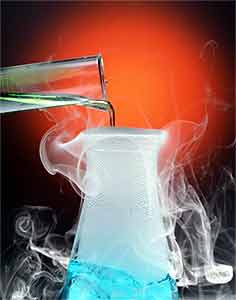 |
|

Uranium — silver-white brilliant metal. Metal uranium exists in three allotropes. To 669 °C α-modification with orthorhombic a lattice, parametres α = 0,2854 nanometers, β = 0,5869 nanometers and c = 0,4956 nanometers, density of 19,12 kg/dm3 is inconvertible. From 669 °C to 776 °C β-modification with a tetragonal lattice (parametres α = 1,0758 nanometers, c = 0,5656 nanometers). To temperature of fusion 1135 °C β- modification with the cubic volume-aligned lattice (α = 0,3525 nanometers). Temperature of boil 4200 °C.
Chemical activity of metal uranium is high. On air it is coated film oxide. Powdery uranium pyrophorus, at combustion of uranium and thermal Decomposition of its many linkings on air it is formed oxide uranium U3O8. If this oxide to heat up in hydrogen atmosphere at temperature above 500 °C, It is formed dioxide uranium UO2 — chemical formula:
U3O8 + Н2 = 3UO2 + 2Н2О
If uranylnitrate UO2(NO3)2 to heat up at 500 °C, that, Decaying, it forms trioxide uranium UO3. Except oxides of uranium of a stoichiometric composition UO2, UO3 и U3О8, oxide of uranium of composition is known U4O9 and some metastable oxides and oxides of variable composition.
At fusion of oxides of uranium with oxides of other metals uranates are formed: К2UO4 (potassium uranate), СаUO4 (calcium uranate), Na2U2O7 (diuranat sodium).
Interreacting with halogens, uranium yields uranium halogenides. Among them hexafluoride UF6 Represents the yellow crystal substance easily sublimating even at weak heating (40-60 °C) and so easily hydrolyzed by water. The major practical value has hexafluoride uranium UF6. It receive interaction of metal uranium, oxides of uranium or UF4 with fluorine or fluorinating agents BrF3, СCl3F (freon-11) or ССl2F2 (freon-12):
U3O8+ 6CCl2F2 = UF4 + 3COCl2 + CCl4 + Cl2
UF4+ F2= UF6
or
U3O8+ 9F2 = 3UF6+ 4O2
Fluorides and the chlorides answering to oxidation states of uranium are known +3, +4, +5 and +6. Uranium bromides are received UBr3, UBr4 and UBr5, and also uranium iodides UI3 and UI4. The such are synthesised oksigalogenids uranium, as UO2Cl2 UOCl2 and others.
At interaction of uranium with hydrogen uranium hydride is formed UH3, Possessing high reactivity. At heating hydride decays, Forming hydrogen and powdery uranium. At sintering of uranium with boron arise, in Dependences on a molar ratio of reagents and conditions of carrying out of process, Borides UB2, UB4 and UB12.
With carbon uranium forms three carbides UC, U2C3 and UC2.
Interaction of uranium with silicon receives silicides U3Si, U3Si2, USi, U3Si5, USi2 and U3Si2.
Uranium nitrides are received (UN, UN2, U2N3) and uranium phosphides (UP, U3P4, UP2). With sulphur uranium forms a number of sulphides: U3S5, US, US2, US3 and U2S3.
Metal uranium dissolves in HCl and HNO3, sluggishly reacts with H2SO4 and H3PO4. There are the salts containing cation of uranyl UO22+.
In water solutions there are uranium connections in oxidation states from +3 to +6. Standard oxidation potential of pair U(IV)/U(III) — 0,52 V, pair U(V)/U(IV) 0,38 V, pair U(VI)/U(V) 0,17 V, pair U(VI)/U(IV) 0,27. Ion U3+ in a solution it is unstable, an ion U4+ It is stable for lack of air. Cation UO2+ It is astable and in a solution disproportionation on U4+ and UO22+. Ions U3+ have characteristic red colouring, ions U4+ — green, ions UO22+ — yellow.
In solutions uranium connections in oxidation state are steadiest +6. All connections of uranium in solutions are inclined to hydrolysis and complexing, is the strongest - cations U4+ and UO22+.
(c) 2007-2023 Uranium, energy and industry | Copying of site materials is allowed with an active link to ueip.org
Privacy policy | Contact